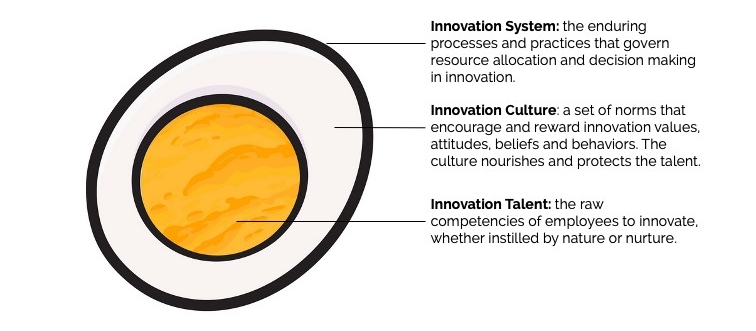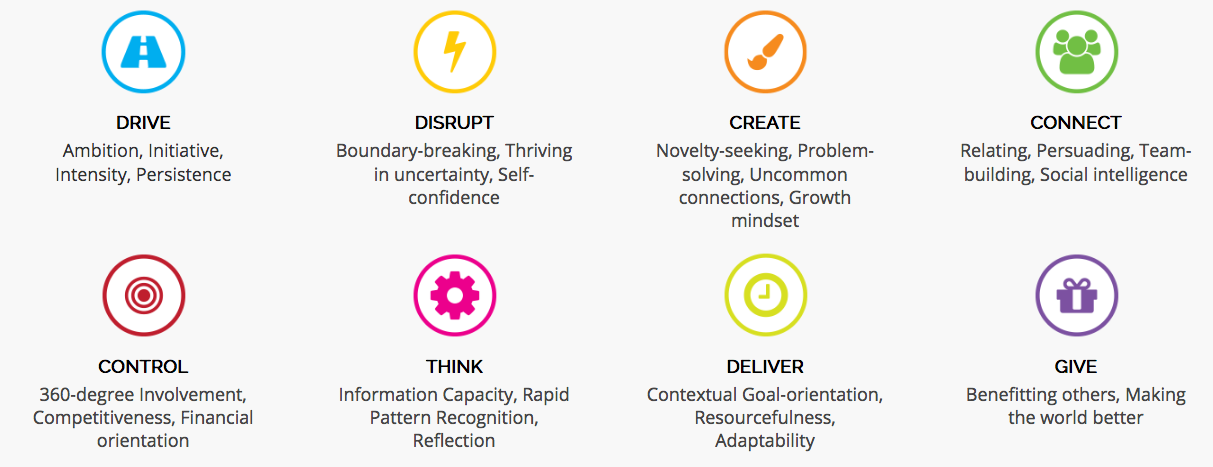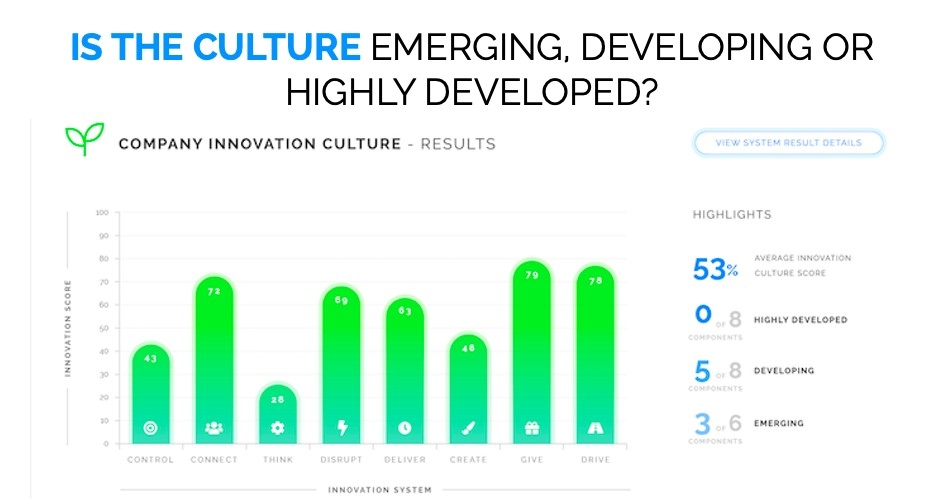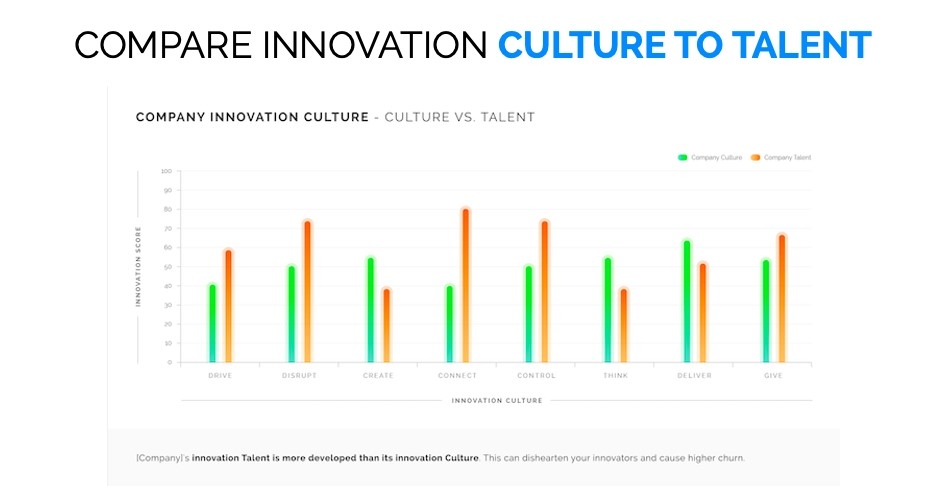The Ultimate Guide to
Driving an Innovation Culture
BECAUSE INNOVATION CULTURE SUPPORTS EMPLOYEES
BECAUSE INNOVATION CULTURE SUPPORTS EMPLOYEES
TABLE OF CONTENTS
What is a Culture of Innovation?
What are the benefits of a Culture of Innovation?
How can you recognize a Culture of Innovation?
How a Culture of Innovation drives employee engagement
What is the context of an innovation culture?
What are the ingredients of a Culture of Innovation?
The eight behaviors an innovation culture must support
Glossary of the 8 Innovation Culture Dimensions (And how your Culture may be thwarting them)
How to measure your innovation culture
Leaders need to reflect on the culture assessment findings
Leaders should then set, and communicate, goals for change
Cascade the goals down to KPIs through all levels of the organization
Ensure leadership models the desired behaviors
Recognize and deal with resistors and blockers
Celebrate successes; culture change is not a won and done
In the field of corporate innovation, one of the most often-used terms is a “Culture of Innovation.” It sounds so appealing. Who wouldn’t want one? Yet in our opinion, this important topic remains way too vague. It is obscured by layers of “fairy dust,” fallacies and naive imitation. Exactly what is a Culture of Innovation? How can you design and create one that produces real results for your organization? How can you avoid the mistakes other organizations make along the way? That is the subject of this article, which is written with both the newcomer and the seasoned innovation professional in mind.
At the highest level, any culture is a set of common values, attitudes, beliefs and behaviors that bind a group of people together. The culture acts as short-hand for how to conduct oneself in order to belong and thrive in that group. Similarly, a workforce culture is short-hand for how to conduct oneself in order to belong and thrive in that organization – be that a company, government agency or a non-profit.
A Culture of Innovation is a set of norms in an organization that encourages and rewards the values, attitudes, beliefs and behaviors that drive innovation.
A Culture of Innovation is a set of norms that encourage and reward innovation values, attitudes, beliefs and behaviors.
There are many benefits to a strong innovation culture. A Culture of Innovation produces more innovation than a culture that prizes conformity and standardization. And companies with a strong innovation culture tend to outperform those with a weak innovation culture. In fact, the most innovative companies in the world enjoy a massive “market cap premium.” This means their shares are worth a lot more per dollar of revenue than less innovative peers. That ought to be enough reason for most companies to want an innovation culture!
You can recognize a Culture of Innovation by its results. A Culture of Innovation is one that regularly generates novel solutions for the organization. These solutions create financial and societal value greater than the status quo.
You can also recognize a Culture of Innovation in an organization by the behavior of its workforce. Employees in organizations with a strong innovation culture tend to feel free to challenge the status quo and experiment. They are also more resilient to change and setbacks. Finally, a strong innovation culture tends to produce higher employee engagement. Of course, you can also assess innovation culture. We will get to this later.
We believe the reason that a strong innovation culture drives high employee engagement is that at a fundamental level, innovating is human. The impulse and ability to alter our world according to our imaginations separates humans from all of the other species. In contrast, a culture that discourages innovation asks workers to leave a vital part of themselves at home.
Lacking the freedom to innovate makes employees feel that they cannot impact the world around them through their work. Over time, this leads to disengagement. In contrast, highly engaged workers identify with their work and with their organizations. They also feel a strong sense of agency and tend to give discretionary effort above and beyond basic job requirements.
The impulse and ability to alter our world according to our imaginations is what separates humans from all of the other species.
An innovation culture does not exist in a vacuum. It is sandwiched between two other organizational design components. The innovation culture lives within the larger innovation system – the enduring processes and practices that govern resource allocation and decision making in innovation.
Picture the innovation system as the eggshell protecting the egg inside. This allows in plentiful oxygen from the outside. The innovation culture is like the fluid, the eggwhite, that protects and nurtures the employees. And finally, we have the innovation talent of the employee, the embryo, that works within that culture day-to-day.
This article will focus on innovation culture. But let’s be clear – despite the immense value of the innovation system and culture, they are necessary but not sufficient elements to systematically produce innovation. At the end of the day, it is the employees who do the innovating. The culture and system guide and support them.
Let’s explore this metaphor further, and envision these three components like an egg:

We will address the six dimensions of a strong innovation system and how to identify your innovation talent in other articles. For now, let’s hone in on the eggwhite, the innovation culture:
Where such an innovation culture is lacking, we have to create the right culture from scratch. Like cooking an unfamiliar recipe, we need to first obtain the ingredients. Then we need to learn how to combine and leaven them.
In this article, we will lay out the ingredients of a Culture of Innovation and describe the steps to achieving one. But first, let’s dispense with some fallacies that otherwise will waste your time and money as you strive to create your own innovation culture:
With our twenty years of experience in corporate innovation, we have encountered all kinds of ideas about how to create an innovation culture. These tend to range from the superficial to the episodic.
These approaches have their merits and are better than doing nothing. And it is easy to understand why these approaches are so popular. It’s because they don’t require any substantive or lasting change in the organization. Superficial approaches to innovation culture can make it appear that you are innovating. But most corporate innovation labs end up sitting empty, or being used as cool meeting spaces. Episodic activities do temporarily take employees out of their everyday context. They can create excitement and hope. But when the ideas or MVPs fail to be implemented, they can also lead to disenchantment. And episodic approaches, being of limited duration, won’t likely change the overarching culture. With any budget challenges, they will be the first programs cut. So you see, the prevailing approaches to innovation culture are doomed for the very reason they are popular: they avoid any substantive or lasting culture change.
The prevailing approaches to innovation culture are doomed for the very reason they are popular: they avoid any substantive or lasting culture change.
Along with these misguided approaches to innovation culture, there is also a shocking lack of science and substance on the subject. Being science nerds here at Swarm, we thought we’d put our money where our mouth is. We conducted a major research study on innovation outcomes across numerous industry segments. It was conducted on a large international sample of serial innovators and a general population control group. The research took place over four waves. It revealed eight behaviors or innovation talents that distinguish serial, successful innovators from the general population. These eight behaviors are highly predictive of real-world innovation outcomes, such as profitability, global expansion, acquisitions and IPOs.
The study was focused on individual innovation talent – not on the organizational level, so we were not expecting any insights on culture. But the study ended up scientifically defining the attitudes, beliefs, values and behaviors of successful innovators. It was only later that we realized these are the same behaviors any innovation culture must support if it hopes to drive innovation outcomes.
The study scientifically defined the attitudes, beliefs, values and behaviors of successful innovators.
Remember, the role of innovation culture is to encourage and reward innovation values, attitudes, beliefs and behaviors in employees. So it follows that these are the same eight behaviors the innovation culture should advance:

Anyone involved in driving a Culture of Innovation should start by understanding these eight behaviors. Here is a quick glossary of the eight Innovation Talents:
(And How your Culture May Be Thwarting Them)
Large organizations often prefer to focus on incremental projects to avoid risk. They don’t allocate sufficient time for an employee to follow-through on an idea. And they may punish employees for failing.
Large organizations tend to be top-down driven, so employee-led ideas may struggle for resources. Large organizations may also be consensus-driven, which for novel approaches is difficult to achieve.
Large organizations are designed for stability, so they tend to minimize outside change, dismiss novelty, and punish non-conformity. They are siloed, so making connections between a problem in your business and a solution in another business unit or function is structurally discouraged.
Employees may be discouraged from socializing outside their immediate unit, having direct customer contact, or going to anyone but their immediate supervisor for resources.
Employees in large organizations are highly specialized, and are often told they must “stay in their swim lane.” Money is a department (finance or accounting), and employees have little insight into the impact of their day-to-day work on financial performance.
Large organizations tend to be backward-facing, demanding years of historical data to support decisions. They tend to primarily concern themselves with their own sector and so may miss larger emerging patterns.
Large organizations tend to work on long, fixed planning cycles. Thus they may dismiss change rather than adapt to emerging opportunities. Deviations from plan are often punished.
Many large organizations espouse a commitment to customer well-being in their mission statements. But in their day-to-day work, most organizations do not enable employees to witness the impact of their work on real customers. Companies have historically accepted social responsibility for their actions and products when litigation, or customers, have demanded it.
You can delve into more detail on the eight innovation talents, and learn about innovators who embody each of these talents, in this simple guide. And read more about innovation talent assessments here.
As Peter Drucker, the renowned management consultant, once said, “What you don’t measure, you can’t change.” So we recommend that you take a baseline measure of your innovation culture and set some goals for change. Then re-measure the culture every 6-12 months.
In your search for the right culture assessment for your organization, be wary of instruments that mix up innovation culture and innovation systems.
There are any number of innovation culture assessments out there. Some are based on research, others more on observation and opinion. In your search for the right culture assessment for your organization, be wary of instruments that mix up innovation culture (which is about supporting desired employee behaviors) and innovation systems (which are about resource allocation and decision-making).
To drive this point home, let’s talk about some examples we have seen:
In terms of your sample size, here are some easy rules of thumb. For any organizational assessment, you need at least a 95 percent confidence level. You also need no more than a +/- 3 percentage point margin of error for the results to be credible. Here are the minimum sample sizes for different workforce populations:

You can calculate the sample size required for different population sizes here.
Keep in mind that for any “unit” you want to compare to another “unit” (say one business unit or location to another) you need to collect a sufficient sample from each unit for the findings to be reliable. Let’s say, for example, you want to compare IT in North America with IT in Europe, and they each have 500 employees. You would need to sample 341 IT employees in each of the two locations.
If you don’t follow this guideline, you may find yourself comparing a subset of employees to another subset. Each subset would be well below the required sample size for reliable results. For example, say you sample 500 employees across North America and Europe out of a total employee base of 50,000. Then a manager wants to drill down to look at the IT function in each of these locations. You only have 95 IT employees in Europe and 213 in North America. Comparing these two sub-samples will produce results with a wide margin of error. This could be as high as 10 percentage points in either direction. You really can’t draw any solid conclusions from such results.
Once you’ve measured the innovation culture, the next step is for the leadership team to honestly reflect on the findings.

Once you get your innovation culture assessment results, what should you compare your results to? A good culture instrument will provide some sort of rating system based on research. It will allow you to benchmark your organization against your sector and against innovation leaders.

One big caution here: Leadership tends to focus on the culture that they experience. But the rank and file may have a very different experience. They usually do, because leaders may be exempt from some rules, or know how to work the rules. Be sure to gather feedback on the innovation culture throughout the organization. Don’t forget to compare the views of leadership to the views of the rank and file. If the innovation culture is real, it will be felt all the way down to the people who water the plants!

Finally, your innovation culture is a reflection of the behaviors that you tend to recruit for, support and reward. So over time, your culture will also shape your talent. A company culture that discourages creativity will also eventually have less creative employees. Creative thinkers won’t be attracted to the company, and won’t stay long. They also will suppress their creativity to align with tacit culture norms.

Once you identify your innovation culture strengths and gaps through reflection (and if you use Swarm, the aggregated data views such as the above), leadership can set goals for change. For example, what if your organization culture is weak on Think and Control? You can reward employees for recognizing emerging trends earlier (Pattern Recognition: Think). You can also expose employees to more aspects of the business (360-degree involvement: Control).
Just because leadership announces a new initiative doesn’t mean the middle will follow. In fact, many middle managers are experts at dodging the “initiative du jour” until it peters out. Unless a goal is on a manager or employee’s KPIs (or OKRs), don’t expect it to be taken seriously. Goals must be tangible and measurable. You must reward leaders, managers and employees alike for meeting the KPIs (or OKRs) if you want the behavior change to continue.
Goals must be tangible and measurable. You must reward leaders, managers and employees alike for meeting the KPIs (or OKRs) if you want the behavior change to continue.
Since culture is set from the top, it seems obvious that leaders must model the very behaviors that your innovation culture is designed to promote. If you say you want a culture more conducive to disruptive innovation, but leaders punish anyone who questions the status quo, you won’t get very far in your culture change. Leaders’ compensation should, in part, be dependent on them personally meeting their innovation culture KPIs, and on the organization making progress toward its culture goals.
It’s also a good idea to include representation of strong innovators on the leadership team. This signals like nothing else that innovators will be rewarded in your culture. Innovators bring a different perspective and skill set to decision-making than individuals who are content with the status quo. For innovation to really happen in the company, innovators must be present on the leadership team. They must also be part of making the day-to-day decisions that determine company strategy and resource allocation. You can use an innovation assessment to identify leaders with the desired attitudes, values and behaviors.
Leaders’ compensation should, in part, be dependent on them personally meeting their innovation culture KPIs, and on the organization making progress toward its culture goals.
In any change initiative, you will face resistance. As you launch an innovation culture initiative, those who repeatedly block, resist or undermine the desired innovation culture must be put on notice. You can’t say that you want a Culture of Innovation while also tolerating these antibodies that kill all progress. A study of transformation initiatives across many companies found one of the major errors was not dealing with blockers earlier.
So what can you do with resistors and blockers? They can be moved to roles where innovation is less critical, such as in roles where existing procedures must be upheld for compliance. Clearly, after written warnings and a suitable time to cure the destructive behavior, resisters and blockers can be removed through your company’s sanctioned processes. Be sure to work with Legal on this to dot all of the I’s and cross all of the T’s.
Decisive action (or the failure to take it), says more about how serious you are about innovation culture than 10,000 words. Employees watch what we do, not what we say!
As you take the above steps, be sure to celebrate even small successes and progress on the innovation culture. Change tends to happen in small moments that can become “teachable moments.” In one recent project with a Fortune 50 customer, a leader stopped herself mid-sentence from killing an employee initiative because the resources were not all lined up yet to scale it. Instead, she approved the employee testing an MVP to get user feedback.
It’s also a good idea to create a company-wide communication channel for regular updates on innovation culture. Be sure to share not just successes, but struggles and learnings on the innovation journey. Emphasize a love of learning and a growth mindset.
Leverage teachable moments. In one recent project with a Fortune 50 customer, a leader stopped herself mid-sentence from killing an employee initiative because the resources were not all lined up yet to scale it. Instead, she approved the employee testing an MVP to get user feedback.
As Drucker said, “What you don’t measure you can’t improve,” right? So you need to monitor the innovation culture regularly. At minimum, you need to measure the innovation culture annually. Once you have your baseline study, a good approach to avoid survey burnout is progressive sampling. This is where you ask culture diagnostic questions to a random sample of the workforce on a rolling basis. For example, this could happen quarterly or twice-yearly.
To summarize the ten key points in this article:
The payoff for a true Culture of Innovation is abundant and manifold. First, innovation drives growth and ensures that you retain a lead over your competitors in the market. Innovative companies attract high quality talent, And last but not least, for every dollar of revenue a company earns, the market valuation for innovative companies is significantly higher. Which is why investment in a Culture of Innovation should be a priority for the C-suite.
Innovation culture is a popular topic, but one that has been shrouded in unnecessary vagueness. We hope this article dispels some of the mystery surrounding innovation culture in the workplace.